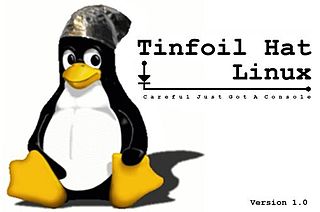Related Research Articles
Pretty Good Privacy (PGP) is an encryption program that provides cryptographic privacy and authentication for data communication. PGP is used for signing, encrypting, and decrypting texts, e-mails, files, directories, and whole disk partitions and to increase the security of e-mail communications. Phil Zimmermann developed PGP in 1991.

Public-key cryptography, or asymmetric cryptography, is the field of cryptographic systems that use pairs of related keys. Each key pair consists of a public key and a corresponding private key. Key pairs are generated with cryptographic algorithms based on mathematical problems termed one-way functions. Security of public-key cryptography depends on keeping the private key secret; the public key can be openly distributed without compromising security. There are many kinds of public-key cryptosystems, with different security goals, including digital signature, Diffie-Hellman key exchange, public-key key encapsulation, and public-key encryption.
The Secure Shell (SSH) Protocol is a cryptographic network protocol for operating network services securely over an unsecured network. Its most notable applications are remote login and command-line execution.

GNU Privacy Guard is a free-software replacement for Symantec's cryptographic software suite PGP. The software is compliant with the now obsoleted RFC 4880, the IETF standards-track specification of OpenPGP. Modern versions of PGP are interoperable with GnuPG and other OpenPGP v4-compliant systems.
CAcert.org is a community-driven certificate authority that issues free X.509 public key certificates. CAcert.org relies heavily on automation and therefore issues only Domain-validated certificates.

OpenSSL is a software library for applications that provide secure communications over computer networks against eavesdropping, and identify the party at the other end. It is widely used by Internet servers, including the majority of HTTPS websites.
deb is the format, as well as filename extension of the software package format for the Debian Linux distribution and its derivatives.
S/MIME is a standard for public-key encryption and signing of MIME data. S/MIME is on an IETF standards track and defined in a number of documents, most importantly RFC 8551. It was originally developed by RSA Data Security, and the original specification used the IETF MIME specification with the de facto industry standard PKCS #7 secure message format. Change control to S/MIME has since been vested in the IETF, and the specification is now layered on Cryptographic Message Syntax (CMS), an IETF specification that is identical in most respects with PKCS #7. S/MIME functionality is built into the majority of modern email software and interoperates between them. Since it is built on CMS, MIME can also hold an advanced digital signature.
In computer security, a sandbox is a security mechanism for separating running programs, usually in an effort to mitigate system failures and/or software vulnerabilities from spreading. The sandbox metaphor derives from the concept of a child's sandbox—a play area where children can build, destroy, and experiment without causing any real-world damage. It is often used to kill untested or untrusted programs or code, possibly from unverified or untrusted third parties, suppliers, users or websites, without risking harm to the host machine or operating system. A sandbox typically provides a tightly controlled set of resources for guest programs to run in, such as storage and memory scratch space. Network access, the ability to inspect the host system, or read from input devices are usually disallowed or heavily restricted.
The OpenBSD operating system focuses on security and the development of security features. According to author Michael W. Lucas, OpenBSD "is widely regarded as the most secure operating system available anywhere, under any licensing terms."
cryptlib is an open-source cross-platform software security toolkit library. It is distributed under the Sleepycat License, a free software license compatible with the GNU General Public License. Alternatively, cryptlib is available under a proprietary license for those preferring to use it under proprietary terms.
This is a technical feature comparison of different disk encryption software.
Email encryption is encryption of email messages to protect the content from being read by entities other than the intended recipients. Email encryption may also include authentication.

Tinfoil Hat Linux (THL) is a compact security-focused Linux distribution designed for high security developed by The Shmoo Group. The first version (1.000) was released in February 2002. By 2013, it had become a low-priority project. Its image files and source are available in gzip format. THL can be used on modern PCs using an Intel 80386 or better, with at least 8 MB of RAM. The distribution fits on a single HD floppy disk. The small footprint provides additional benefits beyond making the system easy to understand and verify. A hard drive is not required to use THL, making it easier to "sanitize" the computer after use.
In cryptography, Curve25519 is an elliptic curve used in elliptic-curve cryptography (ECC) offering 128 bits of security and designed for use with the Elliptic-curve Diffie–Hellman (ECDH) key agreement scheme. It is one of the fastest curves in ECC, and is not covered by any known patents. The reference implementation is public domain software.

Linoma Software was a developer of secure managed file transfer and IBM i software solutions. The company was acquired by HelpSystems in June 2016. Mid-sized companies, large enterprises and government entities use Linoma's software products to protect sensitive data and comply with data security regulations such as PCI DSS, HIPAA/HITECH, SOX, GLBA and state privacy laws. Linoma's software runs on a variety of platforms including Windows, Linux, UNIX, IBM i, AIX, Solaris, HP-UX and Mac OS X.

OpenSSH is a suite of secure networking utilities based on the Secure Shell (SSH) protocol, which provides a secure channel over an unsecured network in a client–server architecture.

Cryptocat is a discontinued open-source desktop application intended to allow encrypted online chatting available for Windows, OS X, and Linux. It uses end-to-end encryption to secure all communications to other Cryptocat users. Users are given the option of independently verifying their buddies' device lists and are notified when a buddy's device list is modified and all updates are verified through the built-in update downloader.
In public-key cryptography, Edwards-curve Digital Signature Algorithm (EdDSA) is a digital signature scheme using a variant of Schnorr signature based on twisted Edwards curves. It is designed to be faster than existing digital signature schemes without sacrificing security. It was developed by a team including Daniel J. Bernstein, Niels Duif, Tanja Lange, Peter Schwabe, and Bo-Yin Yang. The reference implementation is public-domain software.

Mailfence is an encrypted email service with a focus on security and privacy that offers OpenPGP based end-to-end encryption and digital signatures for usage in emails. It was launched in November 2013 by Belgium-based company ContactOffice Group, which has been operating an online collaboration suite since 1999.
References
- 1 2 3 4 5 "signify(1)". OpenBSD manual pages. Retrieved 2024-12-11.
- 1 2 3 4 5 "signify: Securing OpenBSD From Us To You". OpenBSD. Retrieved 2024-12-11.
- 1 2 "aperezdc/signify: OpenBSD tool to sign and verify signatures on files. Portable version". GitHub. 2014-01-14. Retrieved 2024-12-11.
- ↑ "stoeckmann/signify-windows: OpenBSD signify for Windows systems". GitHub. 2015-10-20. Retrieved 2024-12-11.
- ↑ "OpenBSD 5.5". www.openbsd.org. Retrieved 12 July 2022.
- ↑ "OpenBSD: Innovations". www.openbsd.org.
- 1 2 3 "sign and verify". flak. 2013-12-31. Retrieved 2024-12-11.
- ↑ "Dive into anything". Reddit. 2024-12-11. Retrieved 2024-12-11.
- ↑ "usign" . Retrieved 2024-12-11.
- ↑ "Verifying authenticity of Debian images". www.debian.org. Retrieved 12 July 2022.
- ↑ "Download Kali Linux Images Securely | Kali Linux Documentation". Kali Linux. Retrieved 12 July 2022.
- ↑ "Verifying signatures". Qubes OS. Retrieved 12 July 2022.
- ↑ "How can I verify Tor Browser's signature? | Tor Project | Support". support.torproject.org. Retrieved 12 July 2022.
- ↑ "Share and accept documents securely". SecureDrop. Freedom of the Press Foundation. Retrieved 12 July 2022.
- ↑ "VeraCrypt - Free Open source disk encryption with strong security for the Paranoid". veracrypt.fr. IDRIX. Retrieved 12 July 2022.